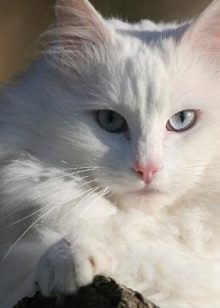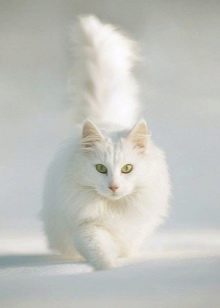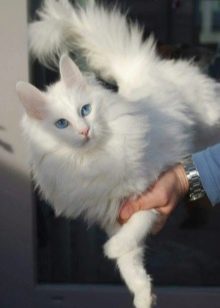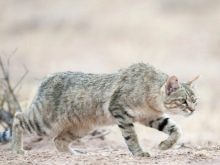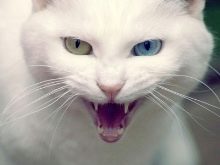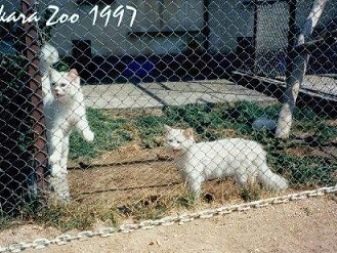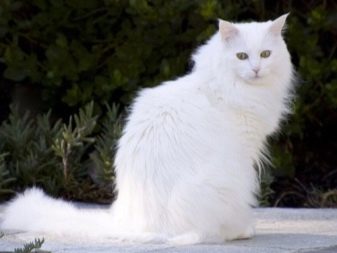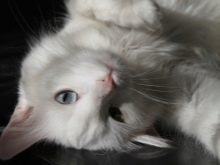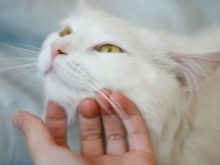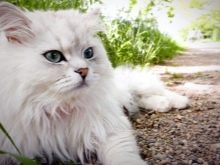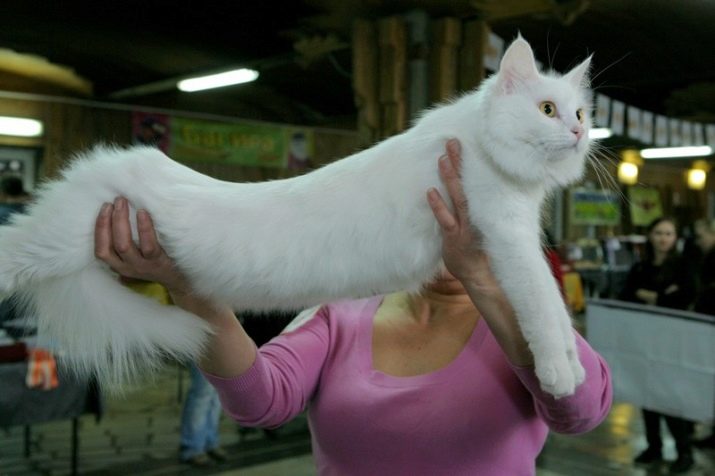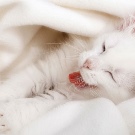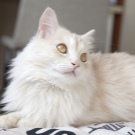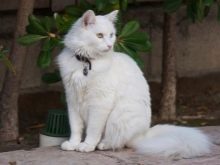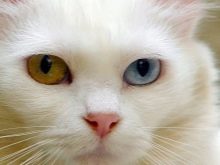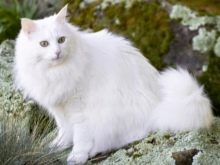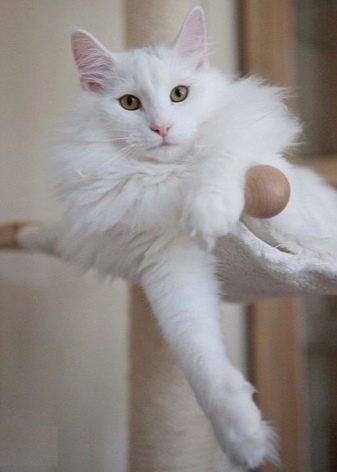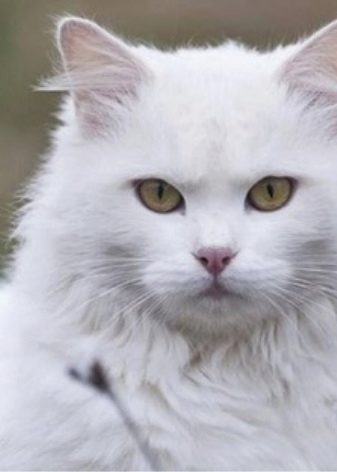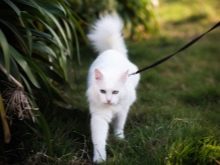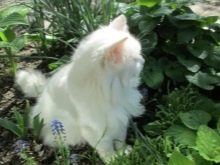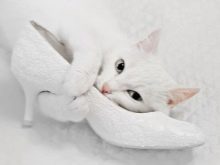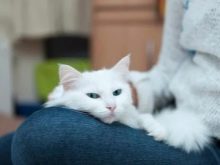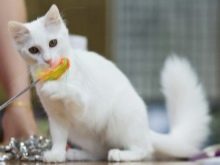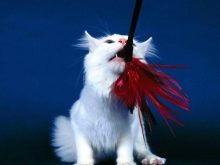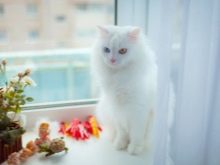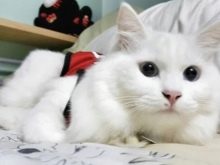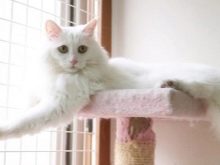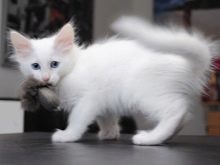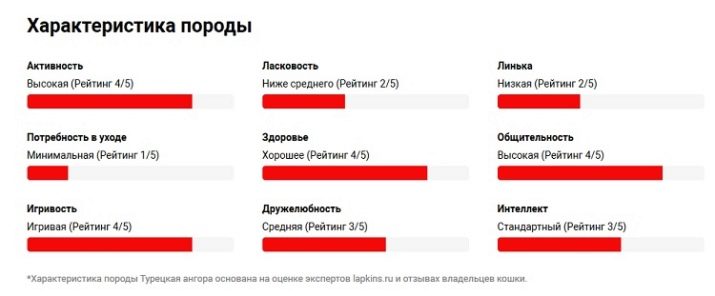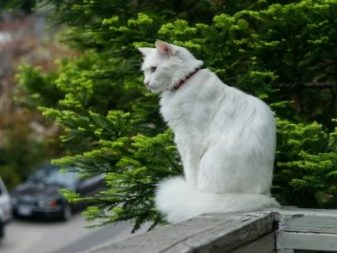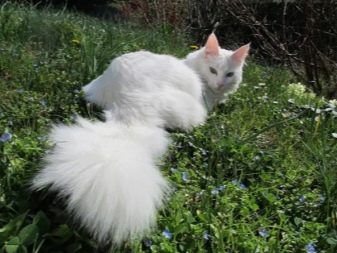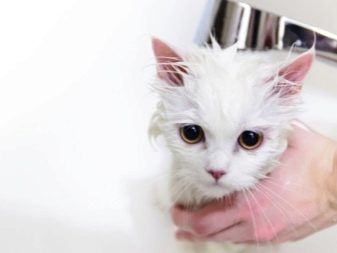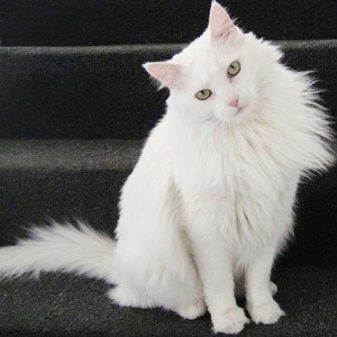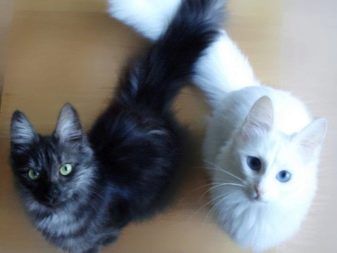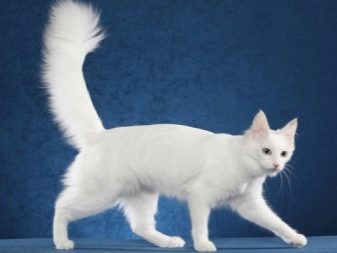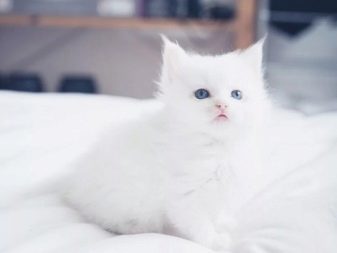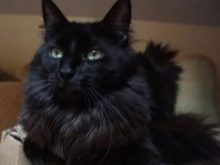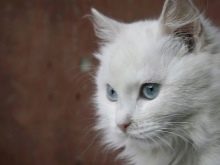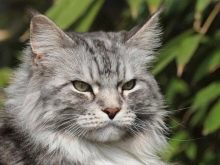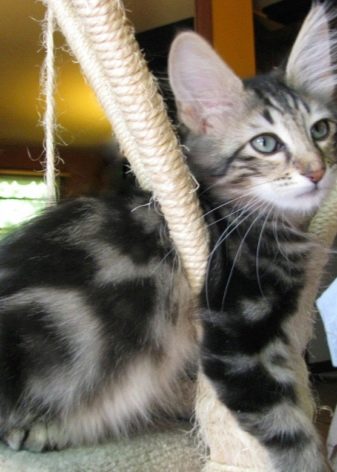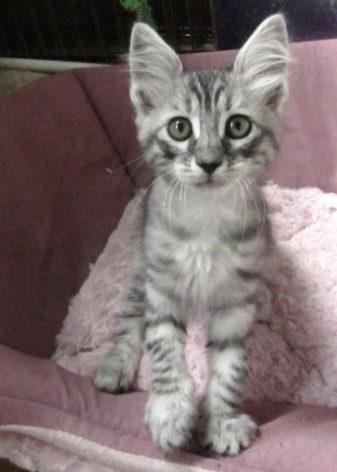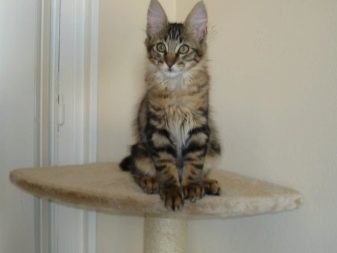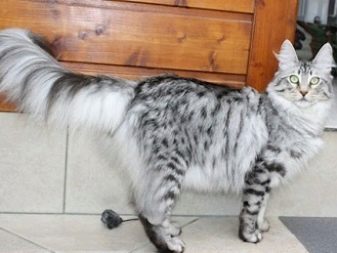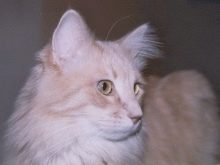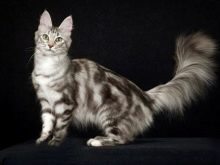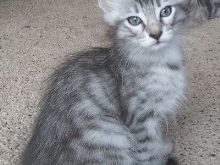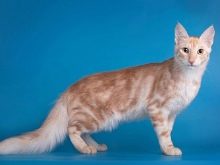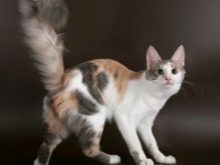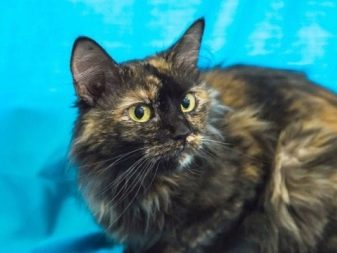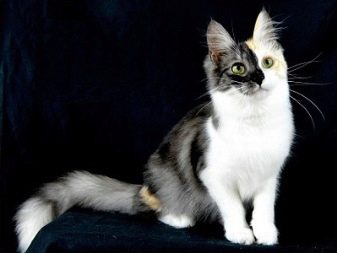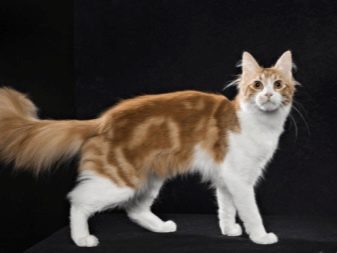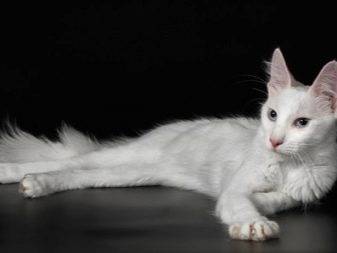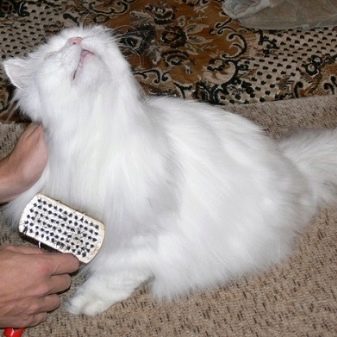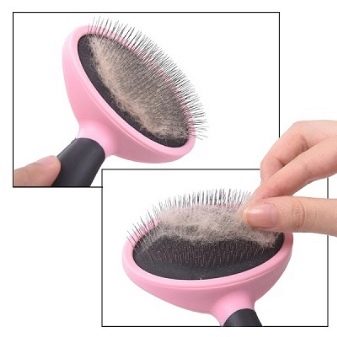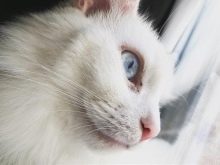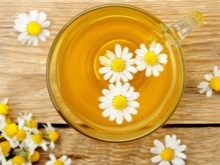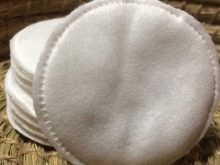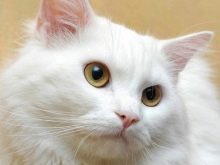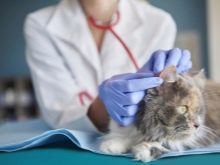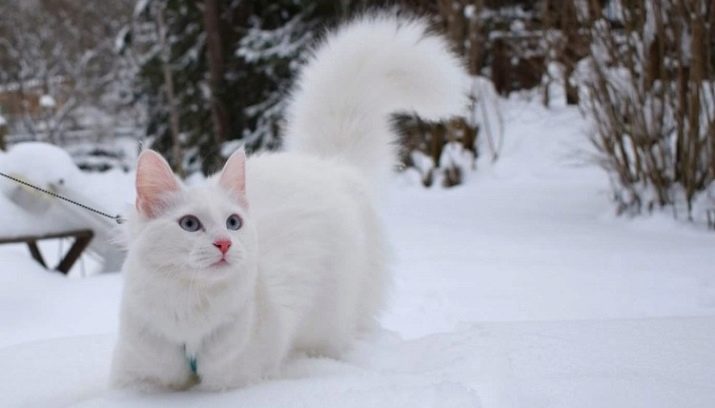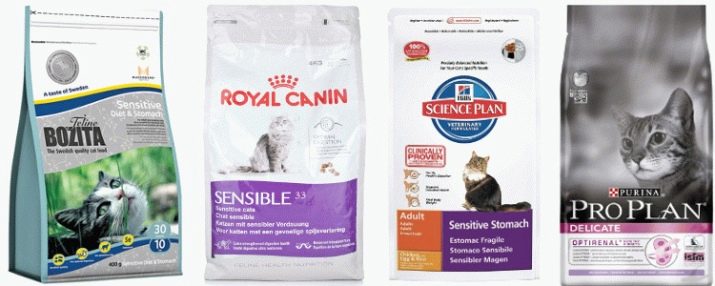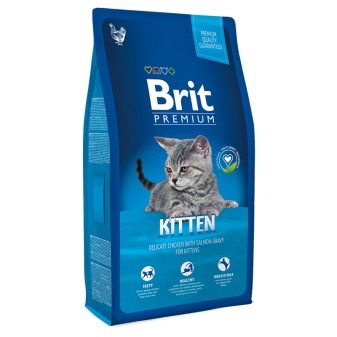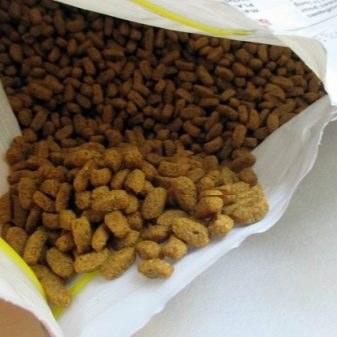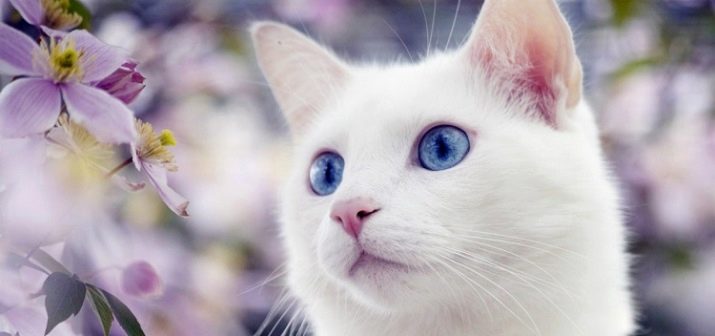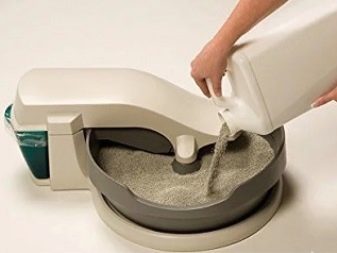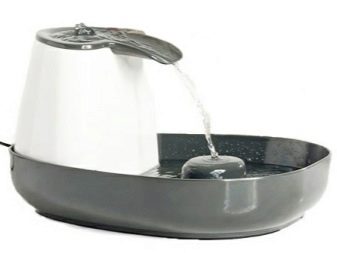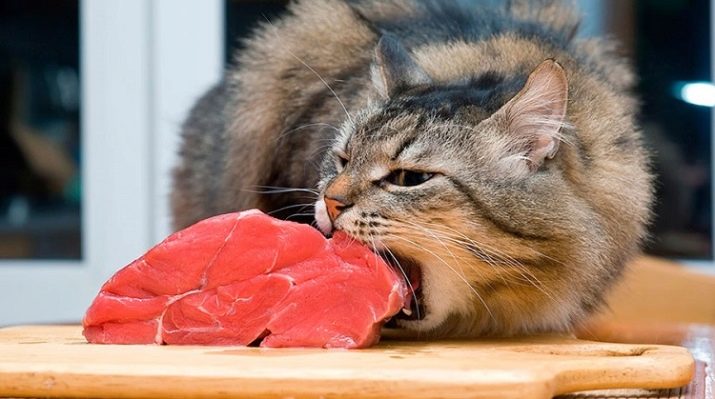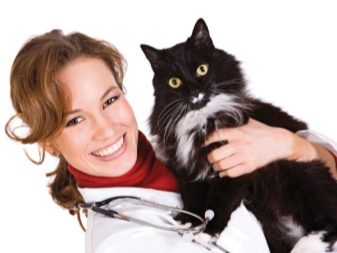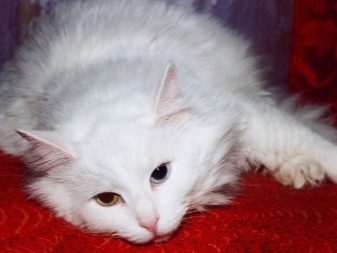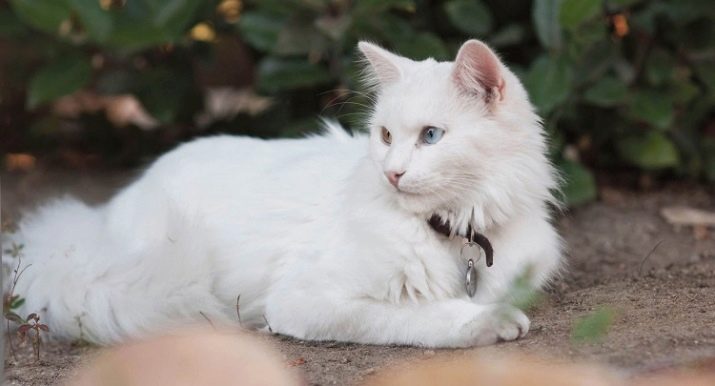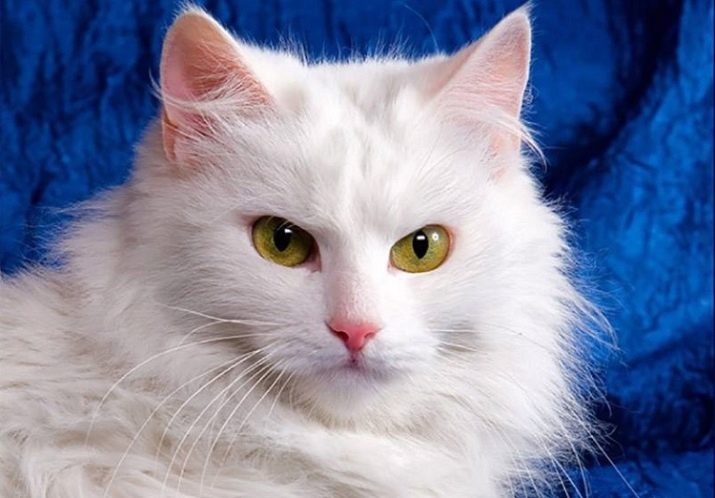Description of Angora cats, their characteristics of keeping and feeding
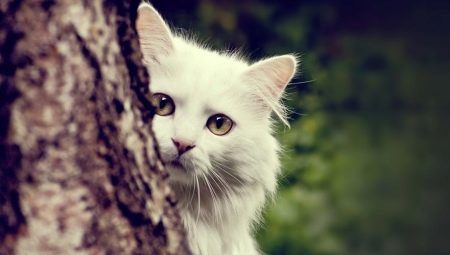
The most common pets are cats. Currently, there are many different breeds of these cute creatures. Among all this diversity, the most ancient and most famous Angora breed of cats is known.
History of origin
Angora cats, as, indeed, all breeds, originates from wild relatives. The ancestor of these cute creatures is considered to be a wild African cat or, as it is also called, a Middle Eastern cat. The first domesticated short-haired descendants of this species were in Turkey (then Eastern Anatolia), from where they were taken to Egypt. Due to the repeated mutation, their wool became not only long, but also acquired a white color recognizable for the breed.
The oldest domesticated cats from Eastern Anatolia are the ancestors of the Van cat. They, like the Turkish Angora, mutation of the gene responsible for the length of wool, occurred gradually. Similar in appearance, these breeds belonging to a single Mediterranean group still have some differences from each other at the genetic level.
The Angora cat, created by the efforts of European and American breeders, has received official status due to the individuals located in Turkey’s Ankara Zoo. They were taken out, and then officially registered in the middle of the twentieth century.
But the breed itself became famous in Europe much earlier. According to some information, the first representatives of the breed were brought to European territory in the XIV century, during the times of military campaigns of a religious orientation. According to other sources, the first long-haired kittens with white color appeared on the territory of Europe only in the XVI century, and an independent breed was recognized only at the beginning of the XVII century.
Representatives of the breed brought to Europe became an adornment of many noble houses. And this is not surprising, because before the appearance of the Angora beauties in Europe there were no long-haired cats.
In Turkey, cats of this breed were very valued and cost fabulous money, so only very rich people could get it. Angora cats lived in the Sultan's palace. The representatives of this breed had a rather high status: they were allowed to enter the mosque and stay there for as long as they pleased. And this is not surprising, because Muslims considered them close to the prophet Muhammad.
By the end of the 16th century, long-haired cats with a white color spread widely throughout Europe. They began to import them to France and the UK not only from the territory of the Byzantine Ankira (Ankara), the birthplace of the breed, but also from Persia (modern Iran), Central Asia and even, oddly enough, from Russia. Angora cats are often used to improve the quality of Persian wool. Mindless cross-breeding led to a sharp decline in the number of Angora cats, which almost led to the complete extinction of these individuals.
Breed began to engage only in the beginning of XX century. The breeding program, approved by the Turkish government in 1917, was aimed not only to preserve the breed, but also to increase the number of individuals. For breeding was chosen zoo Ankars.The Angora breed received official registration in the organization dealing with the breeding of new cats (CFA) only in the mid-twentieth century - in 1973. Until 1978, it was allowed to register only individuals with a white color, but over time, the requirements softened, and it became possible to register cats with other colors.
Each country has the right to accept some amendments in registration. For the UK, only individuals with a pure white color are considered the benchmark, and in the United States cats with other colors are allowed to be registered, but purple and chocolate colors are unacceptable.
Description
Each cat breed has its own standards of beauty and characteristics that Angora animals also have. Representatives of this breed have a medium-sized and even somewhat dry build, but their muscles are still well developed. They are flexible, graceful and very elegant. The weight of cats is traditionally somewhat less than that of cats. For females, the indicator is considered to be in the range of 2.5-3 kg, and for males - in the range of 4-5 kg. The weight of individual representatives may slightly deviate from the norm: for cats - 4 kg, and for cats - 6 kg.
The wedge-shaped type of the head of the Angora cats with a characteristic narrow but strong chin and a well-developed frontal part is one of the distinguishing features of this breed of animals. A long thin neck with a smoothly defined muzzle, on which rather large, wide-set, almond-like eyes stand out, looks very elegant. The color of slightly slanting eyes varies: there are individuals with both green, yellow and blue colors of the iris. Very often, the Turkish variety has heterochromia - dyed eyes.
For the described breed is characterized by large, closely spaced to each other ears with pointed upper tips. In some representatives, the tips of the ears are decorated with tassels consisting of longer hairs compared to the fur on the face. The inside of the auricle is covered with long thick tufts of wool, shaped like a miniature brush.
The limbs of cats of this breed are long, dry, but with well-developed muscles. The length of the hind legs is somewhat longer than the front. The shape of the paws is predominantly oval; between the toes there are thick tufts of fur characteristic of these cats.
A distinctive feature of the breed is a luxurious long tail resembling an ostrich feather. Dense and wide over the entire length and neatly pointed at the tip of the tail is framed with long silky hair.
Angora cats have a very beautiful and silky to the touch fur with a slightly wavy structure in the abdomen. The flowing effect of wool was made possible due to the absence of undercoat - it consists only of guard hairs. The Angora breed has almost no Koltunov and lumps inherent in long-haired cats and cats, since the process of formation of unsightly felted lumps occurs due to the presence of a thick undercoat.
Coat color varies. The classic version is, of course, white. He is the most desired and sought after for such a breed.
Character traits
Angora cats are friendly and very cute creatures. They get along well with all households, but they are most attached to the one who feeds them and spends the most time with them. By strangers treated with caution, but without too much aggression. They will not hiss, and prefer to move away or even hide in a secluded corner. But after some time may come up to sniff a stranger. If they like the smell, and the person does not show aggressiveness towards them, they may even let themselves be stroked or even jumped onto their knees.
Cats of this breed are non-conflicting. The presence of other animals in the house does not affect their lives.Mostly animals prefer to keep a short distance from other representatives of the fauna, but they can make friends with them, especially if contact with people is minimized. There is often a relationship of trust with dogs: some representatives may even eat from a dog bowl and sleep next to them. Relationships with other members of the feline family are fairly neutral. But still, Angora cats prefer the host society more than communion with other animals.
If the family has small children, the cats can become caring “babysitters” for them. They can sit for hours near the crib while the baby is sleeping, or play for a long time with him when he is awake. Tears of a little friend make the cat worry a lot and take a series of actions. She will lick her cheeks, rub and purr until the baby calms down. And if someone raises his voice to the kid or strikes it, the cat may bite the offender - representatives of the breed are not cowardly.
They are not only friendly, but also inquisitive and playful. Representatives of this breed, as, however, and all cats, love to be on high-placed objects. Sitting on a tree, a curtain, a tall closet or on a windowsill, they do not just look, but carefully watch all the objects in her field of view.
Cats are equally interesting and people, and insects, and other animals.
They are also interested in where the owner is at the moment. Turkish varieties of this breed adore to watch every movement of the host and can spend hours chasing him around the house, apartment or garden, demanding increased attention to his person.
Sometimes this behavior becomes even unnecessarily intrusive, because representatives of the breed are famous for their stubbornness and waywardness. In order to achieve certain actions from the owner, they can not only gently rub on the leg or meow, but even bite a little. These cute naughty girls use all the methods available to them to attract the attention of their beloved master. And even their punishment can be difficult to stop, although in normal times they understand perfectly well what a certain act can lead to.
The habits of the Turkish varieties of cats sometimes resemble a dog. According to the owners, cats with pleasure not only play with various objects, but can also bring them to the owner to continue the game. Wearing various objects in the teeth is one of the favorite pastimes of this breed.
According to the owners, cats have good intelligence. They are quite capable of learning how to cope with opening and closing doors in a short time, understand how to get to the switch or electrical device and press a button, and are able to open simple locks of bags. They are easier than other cats to train to perform certain stunts. Due to their intelligence and natural cleanliness, cats get used to a certain location of their toilet from an early age and in a short time.
In addition, they can quickly become accustomed to the claw, which saves the animal from such a barbaric procedure as claw removal. Their natural acumen allows them to quickly adapt to a new habitat.
Cats of the Turkish variety are excellent hunters - they perfectly cope not only with the rodents living on the ground, but also are able to hunt down and catch a bird or an insect during the flight. Their fairly long legs and muscular body allow you to make precise jumps to high surfaces.
Angora cats, unlike other breeds, have practically no fear of water procedures. They are very supportive of watering them with water and even gladly splash in small-volume containers. But they need to be accustomed to water from an early age, but it is better if this is done not without the participation of the mother cat.
Another distinctive feature of the breed is their amazing manner of sound reproduction. Of course, they, like other cats, know how to meow, but their uterine purring without opening a mouth makes an indelible impression. At the same time, representatives of the felines are able to convey their mood, different in emotional coloring, in this way. Cats of this breed with pleasure and a long time can communicate with the owner in this way, and not the usual "meow."
Surprisingly, they react quite vividly to musical sounds. For example, a funny melody can push an animal to play, and a calm and sad song makes them just make a plaintive purr.
Lifespan
The life of cats depends on many factors. This indicator is influenced by the breed's identity, genetic characteristics, living conditions and, of course, nutrition. The average life expectancy of cats is within 10-14 years. Representatives of the Turkish variety live an average of 12 to 15 years. At first glance, this is very small, but cats have their own rhythm of life, and one year of cat life does not equal one human year at all. It is believed that the age of cats should be considered 1 to 7, but this is not entirely true. In the first two years of life, growth and development are much more intensive than in subsequent years, and therefore the first year is approximately 15 human years. The second year equals 24 years of a person’s life, and all subsequent years add to cats 4 years.
Angora cats, living to a 15-year term by human standards, are, though not decrepit, but old people, because they are already about 90 years old. The Turkish variety belongs to the Eastern group, and in the opinion of veterinarians, it is representatives of this group that are distinguished by their endurance and good health. Among them are the most long-lived individuals. With good living conditions and a balanced diet, Angora cats can live up to 20 years, which is quite a lot by human standards.
Kinds
Under this concept should be understood adopted for the breed color standards of wool. For monochromatic colors, only one coat color is characteristic - the guard hair should be completely uniform without the slightest stains, tars and even specks. Under the two-color color means the presence of two colors. The standard is considered and tricolor cats, and the color should be in the form of a certain pattern.
The classic version of the color of this breed is, of course, white. It should be uniform, without the slightest specks of a different shade, while the skin of the paw pads and nose should be pink.
Each country has specific color requirements. For the UK, only individuals with a pure white shade are considered the benchmark, and in the USA smooth-haired cats with a different color are allowed to register. But lilac and chocolate color is unacceptable in any country. In the United States, individuals with white color and blue eyes are not allowed to register, since the transmission of such signs to offspring is fraught with the birth of deaf kittens.
White color is not the only possible for this breed - recently cats with coal-black, blue, cream and even red coat color are in demand.
By accepted standards, cats with black coat and skin color should have the same or brown paw pads. Blue or gray with a silver shimmer coat should be combined with the color of the skin of the nose and pads, and if the coat has a cream shade, the nose and pads should be pink. For the red color of the fur, the skin of the nose and pads should have a slightly lighter tone compared to the fur.
Colors black and blue smoke imply the presence of two shades well matched to each other. In both cases, the main color is either black or gray with a silver tint, and the additional color is white in both cases.
The color of cats with a specific pattern on the wool has different names. Depending on the location of the strips and the patterns they form, the marble tabby and tabby mackerel differ.
For a tabby with a marble pattern, a certain arrangement of stripes is characteristic. On the head, darker compared to the main tone, the stripes form a pattern that visually resembles the letter "M". In the eye area on each side of the outer edge are clearly defined, almost flat lines, ending in the area of the occiput.
From the place where the shoulder joint is located, three bands run across the back. On every barrel cat there are stains and circles. In the neck, the lines have a slight crescent-shaped bend, and from the chest to the abdomen there are small rows of specks arranged in two parallel relative to each other. The tail and legs are outlined with circular lines.
The drawing of a tabby mackerel is a bit similar to the marble one in the arrangement of the strokes on the head, chest and limbs. A cat with the same color on the head has the same letter “M”, and the outer corner of the eye and the back of the head are also connected by a line. The crescent-shaped lines are clearly delineated in the neck, and “bracelets” on the paws and tail. But there are some differences: along the spine there is a thin solid line, originating from the lowest point on the back of the head and ending at the base of the tail. On both sides there are thin solid stripes located perpendicularly relative to the spine line.
Depending on the colors present in the color, there are several different types of tabby (classic mackerel). The main tone can be blue (gray with a silver tint), cream (light beige), brownish-copper (auburn), silver and red.
For silver tabby, the additional tone is black. It is painted pattern lines and paw pads. The skin of the nose has a brick-red hue.
The red tabby look is a pretty bright color. In this case, the darker than the base, the strokes and lines of the picture are very clearly marked.. The skin of the chin and lips coincide in color with the pattern.
The look of a cream tabby is distinguished by a rather delicate color. Darker pattern beautifully stands out against the light background. The skin of the nose and pads is pale pink, and part of the chin and lips match in tone with the base.
Kind of brown tabby. It differs from the others in its bright copper-brown base, against the background of which not only the pattern lines, but also the back region of the limbs are marked in black. The skin on the pads can be either black or brown.
Gray with a silver tint wool blue tabby looks very impressive. At the chin and lips, the skin color coincides with the base, while the lines of the pattern have a slightly darker shade, while the skin of the pads and spout is pink.
Very interesting color has a patchwork tabby. The main background can be either brown, blue or silver. The pattern in the form of spots, in outline resembling scraps of fabric, is colored either in cream or in red.
There is a group of stained colors. The name of each color depends on the color and location of the spots. In most cases, there are 3 shades in color.
In a cat with a tortoise color, the patches of red and cream color palettes are evenly distributed over the entire surface, and there are burn marks on the face with a similar shade. The main color of the background is black.
Color chintz (calico) and chintz clarified. For both colors is more heaped spots in the upper areas of the body and head. The background in the first and in the second color is white, but only calico has red and black spots, while in calico, they have a blue and cream color.
For a cream-blue color, cream is clearly defined and evenly distributed over the entire surface of the spot. The main background has a blue tint.
Color bi-color - a combination of two colors. The main background can be black, red, cream or blue, and white is always an additional color.
Very often the Angora cat is confused with the Anatolian breed (Turkish Shorthair), and this is not surprising, because both breeds belong to a single Mediterranean group. Both in the one and in the other there is a white color and differently colored eyes. They have a visual similarity, but there are significant differences. For example, an Anatolian cat's guard hair is not only short, but also more rigid. In the shorter tail, compared with the Angora breed, the shape of the tip resembles a brush.
Conditions of detention
The Turkish Angora variety belongs to not particularly pretentious breeds and, as a rule, does not require the creation of some exceptional conditions for it. But still it is necessary to follow certain rules to make your pet feel comfortable. Under the content should be understood recommendations for the conduct of hygienic procedures and the organization of leisure of the Angora cat.
Of all the hygiene procedures, of course, is combing. The Angora breed has long hair with a very soft and silky structure, so it requires regular care. The procedure of combing should be carried out at least twice a week, and at the onset of molts occurring in the spring-autumn period, and more often. The process itself is better to start from the head, and then move smoothly to the back, after which you can gently move to the base, and then to the tip of the tail. Belly and paws combed last. As a tool, you must use a brush with an average pile.
The owners, who first became owners of the Angora beauty, often have a question about whether to wash the cat. There is no unequivocal answer to the question, since everything depends on the individual characteristics, color of wool and on trips to exhibitions. Cats are very clean creatures and do not need water procedures. Moreover, in most cases, frequent bathing washes away the protective film from the skin, which can lead to a weakening of the immunity of the animal and, consequently, to the disease. But if the cat often visits the exhibition, and her coat is white in color, then swimming can not be avoided. For water procedures, it is better to use special shampoo for cats, and for animals with white color, regularly attending the exhibition, you can use a tool that removes yellowness.
An equally important hygiene procedure is cleaning the eyes and ears of a cat. To clean the discharge from the eyes, an exceptionally clean cotton pad is used, previously moistened either in boiled water, or in a weak chamomile solution, or in a special solution for the eyes.
To avoid infection, each eye must be treated with a separate disc.
Ears no less than the eyes need regular inspections and treatments. Inspection is carried out for contamination. Cleaning is carried out using special wipes moistened previously in a solution designed to clean the ears. The use of cotton wool or chopsticks for this procedure is undesirable, since there is a high probability of injury to this sensitive organ. Also, do not use hydrogen peroxide as a solution, as it has a drying and not a moisturizing effect.
No less regularly to monitor the condition of the teeth. The appeared deposits on the tooth enamel are cleaned by special means in a compartment with a brush. You can carry out this procedure, of course, independently, but it is better if a veterinarian does this. It is also necessary to monitor the state of claws, or rather, their length.They should be trimmed at least once a week, using special clippers. But, as a rule, Angora cats do not need this procedure - they successfully cope with this task with the help of a scraper. To accustom them to such a subject is quite simple - they understand perfectly why it is needed.
Angora cats are by their nature excellent hunters and explorers. For this reason, if the owner has the opportunity, it is better to periodically release them for a walk - the fresh air and the sun have a beneficial effect on the health of the pet. For walks in the courtyard of animals it is necessary to fix with the help of a leash specially designed for cats, and in a fenced area you can do without it.
It is better to accustom cats of the Angora breed to the toilet tray from an early age. Usually breeders give kittens already accustomed to the toilet, but sometimes the owner has to undertake this mission. The digestive system of cats is designed so that almost immediately after eating, they tend to defecate, so after a meal they must be taken to the tray and wait for the kitten to go to the toilet. As a rule, full addiction occurs in 2-4 weeks.
The size and depth of the tray must be selected on the basis of the weight and age of the cat, and the filler - based on its flowability, environmental friendliness and recyclability.
What to feed?
Proper balanced for all the necessary components of food - the key to good health and longevity of the cat.
Cats belong to the carnivorous group of animals, so their digestive system is designed to digest the thermally unprocessed meat and raw eggs. But the natural type of food is almost always unbalanced as a percentage of the necessary components. This food, though rich in protein, saturates the cat's body with essential amino acids, but it does not have the right balance between such essential trace elements as phosphorus and calcium. The latter, as a rule, is not enough, which inevitably leads to the thinning of bones, teeth and claws. In addition, this type of food does not contain all the vitamins necessary for the cat, which will undoubtedly affect the work of the internal organs, and the preparation of such food takes too much time and effort.
It is much easier and more beneficial for cats to use industrial food, dry or wet food. Moreover, today there are a huge number of manufacturers that produce animal feed.
The argument in favor of the choice of industrial feed is not only their balance in all vitamins and trace elements, but also the variety of tastes presented. It is known that Angora cats do not tolerate monotonous food and very often, in the opinion of many owners, they refuse once-favorite food. Solving the problem with the help of industrial feed is quite simple - you just need to change one taste for another or offer the cat food from another manufacturer.
An important argument in the protection of industrial feeds can be the fact that the cat's snow-white hair from regular use of thermally raw by-products can acquire a slightly yellowish tint, which, of course, does not add to the animal aesthetic appeal, especially if the animal is often taken to exhibitions.
When choosing an industrial feed, one should take into account, of course, the pet's taste preferences. Also do not forget about the quality of the proposed cat product. Preference should be given to premium class feeds, since it is precisely in them that there are no flavor enhancers and dyes. In addition, the share of meat in them is slightly higher than in low-price feeds, and even such vitamins and trace elements are balanced almost perfectly, therefore pets with rare exceptions do not need to be fed with supplements.
Very often, the owners are faced with the question of which feed is best to give: dry or wet. The choice of one or another species depends not so much on the preferences of the animal, but on the host itself. Dry food is very salty, which means that the animal should always have clean water in the bowl. Moreover, Angora cats drink a lot and often.
Dry food for castrated cats is contraindicated, since, according to most veterinarians, it is one of the main causes of urolithiasis. With a natural diet of feeding neutered cats, you should not pamper fish as well, as it contributes to the development of urolithiasis.
The number and frequency of feed depends on the age and condition of the animal. Usually on packs with industrial feed, manufacturers always indicate a single dose depending on weight and age, and the frequency of feedings per day.
Kittens, pregnant cats and weak animals should be fed frequently and in small portions, usually at least 4-5 times a day.
The daily feed rate for an adult healthy animal ranges from 200-250 g. If the pet's diet consists mostly of raw meat, then you need to add some vegetables to it, since the percentage ratio of proteins and carbohydrates in healthy cat food should be 3 to 1. In industrial feeds, the percentage ratio of these components is as close to normal as possible. For adults and healthy individuals, the frequency of feeding is reduced to three times a day. The diet of kittens and weak animals includes, as a rule, supplements with essential trace elements and vitamins. Need a supplement and a cat with a natural diet. For the selection of the necessary supplements it is better to contact your veterinarian.
Regardless of the type of food chosen, and Turkish cats are no exception, animals need special weed consumption. With it, cats get rid of randomly swallowed clumps of wool. Usually they are happy to eat this grass. The main thing is to choose the one you like. You can buy such weed in any pet store, but it is better to grow it yourself, using grains of oats, barley or wheat.
Health
Cats of the Angora breed have fairly good immunity and for this reason are not particularly prone to various diseases. But still they are living beings, and therefore there is always the likelihood of the occurrence of a particular disease. Diseases that can appear in cats are usually divided into three groups: infectious (viral, bacterial, fungal), invasive (parasitic) and non-infectious (congenital or acquired defects of organs and tissues).
Individuals of the Angora breed are prone to certain diseases that are congenital. One of the most common is hypertrophic cardiomyopathy (pathological thickening of the walls of the muscle tissue of the heart).
This disease is the result of a gene mutation and can manifest itself both in young cats, whose age does not exceed 6 years, or in very mature animals, whose age is close to a ten-year mark.
The disease can be asymptomatic, as well as with the manifestation of symptoms characteristic of the disease. To moderately clinical manifestations include:
- labored breathing,
- low degree of stamina
- fatigue
- complete loss of consciousness.
Such animals are usually phlegmatic, passive and very rarely show their motor activity. The diagnosis is made on the basis of echocardiography data, and the treatment is prescribed by a veterinarian and, as a rule, selects drugs for treatment individually. Prevention of the disease is its early detection, continuous monitoring and routine inspection at least once a year.
Another disease of congenital nature is ataxia or cerebellar ataxia.This disease is neurological in nature and manifests itself in the form of impaired coordination of movement. The cerebellum, which is responsible for coordination of movements, is affected even in the womb, therefore clinical symptoms appear immediately as soon as the kitten begins to move actively. Clinical symptoms are considered to be such manifestations as altered gait, widely spaced paws, sudden drops and unnatural shaking of the head..
This disease is diagnosed by MRI, but an experienced veterinarian is able to make a correct diagnosis even after a simple visual examination. There is no cure for this disease, but animals with such a diagnosis can lead quite normal lives, because they do not experience physical pain, and their mental abilities are at a quite high level.
Moreover, many veterinarians agree that when cats live in good conditions and lead an active lifestyle, they may well live to old age.
Another disease that Angora cats have a tendency to have is deafness. Individuals with purely white color of hair and eyes with blue color of the iris are prone to this disease. Angora cats, in which only one eye has a blue iris, are deaf, as a rule, do not suffer, but are carriers of this gene. Sometimes among such individuals there are still cats with one-sided deafness. In order to confirm or disprove this disease, it is necessary to conduct a special test, which can now be done in almost any veterinary clinic.
No less terrible for cats are infectious diseases. The most dangerous include such varieties as rhinotracheitis, infectious peritonitis, calcivirosis, panleukopenia (plague), leukemia and trichophytosis. Timely vaccination saves most diseases. Cats in most cases are vaccinated annually, starting at 10-12 weeks of age. Most modern vaccines can develop immunity from several diseases simultaneously.
The most dangerous diseases of the invasive (parasitic) nature are toxoplasmosis and otodectes. To prevent the cat from getting toxoplasmosis, regular and thorough cleaning of the toilet tray should be carried out, timely de-worming should be carried out, and feeding of raw meat should be refused, giving preference to industrial feed. It is also necessary to follow whenever possible that the cat did not eat the caught rodents, as it is they who are more the source of infection. And, of course, you need to regularly visit a veterinarian for a routine examination.
From the otodektoz save special anti-mite drugs, which are prescribed by a vet. Drops are buried only after the treatment of the auricle.
As a rule, modern drugs help to quickly relieve cats of this disease.
In the next video you are waiting for the features of the Turkish Angora breed.
